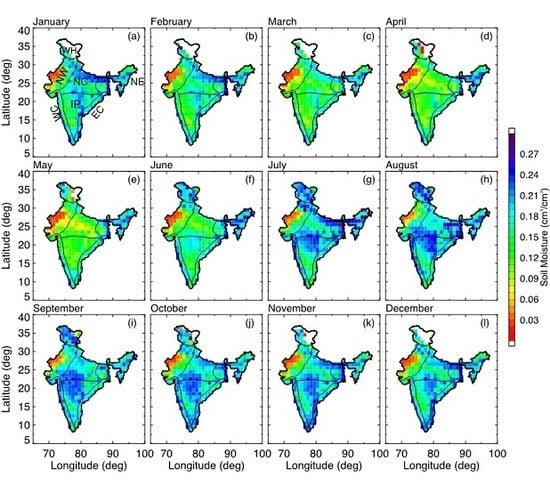Soil Moisture Variability in India: Relationship of Land Surface–Atmosphere Fields Using Maximum Covariance Analysis
Abstract
:1. Introduction
2. Data
2.1. AMSR Soil Moisture
2.2. SMAP Soil Moisture Data
2.3. GRACE Total Water Thickness
3. Methodology
4. Results and Discussion
4.1. Spatial Monthly Variability of Soil Moisture
4.2. Seasonal and Annual Gridded Soil Moisture
4.3. Interannual Variability of Soil Moisture
4.4. Soil Moisture–Precipitation (SM–PR) MCA Results
4.5. Local Temperature Impact on Soil Moisture (SM–TEM)
4.6. Relation Between TCC, TWS and SM
4.7. Spatial Soil Moisture Trends
5. Conclusions
Author Contributions
Acknowledgments
Conflicts of Interest
References
- Seneviratne, S.I.; Corti, T.; Davin, E.L.; Hirschi, M.; Jaeger, E.B.; Lehner, I.; Orlowsky, B.; Teuling, A.J. Investigating soil moisture climate interactions in a changing climate: A review. Earth Sci. Rev. 2010, 99, 125–161. [Google Scholar] [CrossRef]
- GCOS-138. Implementation Plan for the Global Observing System for Climate in support of the UNFCCC-2010 Update; World Meteorological Organization: Geneva, Switzerland, 2010. [Google Scholar]
- Koster, R.D.; Suarez, M.J. The relative contributions of land and ocean processes to precipitation variability. J. Geophys. Res. 1995, 100, 13775–13790. [Google Scholar] [CrossRef]
- Liu, Y. Prediction of monthly-seasonal precipitation using coupled SVD patterns between soil moisture and subsequent precipitation. Geophys. Res. Lett. 2003, 30, 1827. [Google Scholar] [CrossRef]
- Jiang, Y.; Fu, P.; Weng, Q. Assessing the impacts of Urbanization-associated land use/cover change on land surface temperature and surface moisture. Remote Sens. 2015, 7, 4880–4898. [Google Scholar] [CrossRef]
- Huang, J.; van den Dool, H.M.; Georgakakos, P.K. Analysis of model calculated soil moisture over the United States (1991–1993) and applications to long-rangetemperature forecasts. J. Clim. 1996, 9, 1350–1362. [Google Scholar] [CrossRef]
- Wang, W.Q.; Kumar, A. A GCM assessment of atmospheric seasonal predictability associated with soil moisture anomalies over North America. J. Geophys. Res. 1998, 103, 28637–28646. [Google Scholar] [CrossRef]
- Mishra, V.; Shah, R.; Thrasher, B. Soil moisture droughts under the retrospective and projected climate in India. J. Hydrometeorol. 2014. [Google Scholar] [CrossRef]
- Shukla, J.; Mintz, Y. Influence of land-surface evapotranspiration on the Earth’s climate. Science 2015, 215, 1498–1501. [Google Scholar] [CrossRef]
- Asharaf, S.; Dobler, A.; Ahrens, B. Soil moisture-precipitation feedback processes in the Indian summer monsoon season. J. Hydrometoerology 2012. [Google Scholar] [CrossRef]
- Verikoden, H.; Revadekar, J.V. Relation between the rainfall and soil moisture during different phases of Indian monsoon. Pure Appl. Geophys. 2018, 175, 1187–1196. [Google Scholar] [CrossRef]
- Kantharao, B.; Rakesh, V. Observational evidence for the relationship between spring soil moisture and June rainfall over the Indian region. Theor. Appl. Climatol. 2018, 132, 835–849. [Google Scholar] [CrossRef]
- Raman, S.; Mohanty, U.C.; Reddy, N.C.; Alpaty, K.; Madala, R.V. Numerical simulation of the sensitivity of summer monsoon circulation and rainfall over India to land-surface processes. Pure Appl. Geophys. 1998, 152, 781–809. [Google Scholar] [CrossRef]
- Dirmeyer, P.A.; Dolman, J.; Sato, N. The pilot phase of the Global Soil Witness Project. Bull. Am. Meteorol. Soc. 1999, 80, 851–878. [Google Scholar] [CrossRef]
- Koster, R.D.; Dirmeyer, P.A.; Guo, Z.; Bonan, G.; Chan, E.; Cox, P.; Gordon, C.T.; Kanae, S.; Kowalczyk, E.; Lawrence, D.; et al. Regions of strong coupling between soil moisture and precipitation. Science 2004, 305, 1138–1140. [Google Scholar] [CrossRef] [PubMed]
- Dorigo, W.; de Jeu, R.; Chung, D.; Parinussa, R.; Liu, Y.; Wagner, W.; Fernandez-Prieto, D. Evaluating global trends (1998–2010) in harmonized multi-satellite surface soil moisture. Geophys. Res. Lett. 2012, 39, L18405. [Google Scholar] [CrossRef]
- Pariussa, R.M.; de Jeu, R.A.M.; van der Schalie, R.; Crow, W.T.; Lei, F.; Holmes, T.R.H. A Quasi-Global approach to improve day-time satellite surface soil moisture anomalies through the land surface temperature input. Climate 2016, 4, 50. [Google Scholar] [CrossRef]
- Liu, Y.; Zhao, W.; Wang, L.; Zhang, X.; Daryanto, S.; Fang, X. Spatial variations of soil moisture under Caragana Korshinskii Korn from different precipitation zones: Field based analysis in the Loess Plateau, China. Forests 2016, 7, 31. [Google Scholar] [CrossRef]
- Tiwari, V.M.; Wahr, J.; Swenson, J. Dwindling groundwater resources in northern India, from satellite gravity observations. Geo. Phys. Res. Lett. 2009, 36, L18401. [Google Scholar] [CrossRef]
- Njoku, E.G.; Chan, S.K. Vegetation and surface roughness effects on AMSR-E land observations. Rem. Sen. Environ. 2006, 100, 190–199. [Google Scholar] [CrossRef]
- Owe, M.; De Jeu, R.A.M.; Holmes, T.R.H. Multi-sensor historical climatology of satellite-derived global land surface moisture. J. Geophys. Res. 2008, 113, R01002. [Google Scholar] [CrossRef]
- Jones, L.A. Synthesis of Satellite Microwave Observations for Monitoring Global Land-Atmosphere CO2 Exchange. Ph.D. Thesis, College of Forestry and Conservation, Missoula, MT, USA, 2016. [Google Scholar]
- Du, J.; Kimball, J.S.; Jones, L.A.; Kim, Y.; Glassy, J.; Watts, J.D. A global satellite environmental data record derived from AMSR-E and AMSR2 microwave Earth observations. Earth Syst. Sci. 2017, 9, 791–808. [Google Scholar] [CrossRef]
- Entekhabi, D.; Njoku, E.G.; O’Neill, P.E.; Kelogg, K.H.; Crow, W.T.; Edelstein, W.N.; Entin, J.K.; Goodman, S.D.; Jackson, T.J.; Johnson, J.; et al. The Soil Moisture Active Passive (SMAP) mission. Proc. IEEE 2010, 98, 704–716. [Google Scholar] [CrossRef]
- Pan, M.; Cai, X.; Chaney, N.W.; Wood, E.F. An initial assessment of SMAP soil moisture retrievals using high-resolution model simulations and in situ observations. Geophys. Res. Lett. 2016. [Google Scholar] [CrossRef]
- Zeng, J.; Chen, K.S.; Chen, Q. A preliminary evaluation of the SMAP radiometer soil moisture product over United States and Europe using ground-based measurements. IEEE Trans. Geosci. Remote Sens. 2016, 54, 4929–4940. [Google Scholar] [CrossRef]
- Colliander, A.; Jackson, T.J.; Bindlish, R.; Chan, S.; Das, N.; Kim, S.B.; Cosh, M.H.; Dunbar, R.S.; Dang, L.; Pashaian, L.; et al. Validation of SMAP surface soil moisture products with core validation sites. Remote Sens. Environ. 2017, 191, 215–231. [Google Scholar] [CrossRef]
- Kim, H.; Parinussa, R.; Konings, A.G.; Wagner, W.; Cosh, M.H.; Lakshmi, V.; Zohaib, M.; Choi, M. Global-scale assessment and combination os SMAP with ASCAT (active) and AMSR2 (passive) soil moisture products. Remote Sens. Environ. 2018, 204, 260–275. [Google Scholar] [CrossRef]
- Wahr, J.; Molenaar, M.; Bryan, F. Time-variability of the Earth’s gravity field: Hydrological and oceanic effects and their possible detection using GRACE. J. Geophys. Res. 1998, 103, 30205–30230. [Google Scholar] [CrossRef]
- Swenson, S.; Wahr, J. Methods for inferring regional surface-mass anomalies from Gravity Recovery and Climate Experiment (GRACE) measurements of time-variable gravity. J. Geophys. Res. 2002, 107, 2193. [Google Scholar] [CrossRef]
- Rodell, M.; Famiglietti, J.S. An analysis of terrestrial water storage variations in Illinois with implications for the Gravity Recovery and Climate Experiment A(GRACE). Wat. Resour. Res. 2001, 37, 1327–1339. [Google Scholar] [CrossRef]
- Wahr, J.; Zhong, S. Computations of the viscoelastic response of a 3-D compressible Earth to surface loading: An application to glacial isostatic adjustment in Antarctica and Canada. Geophys. J. Int. 2013, 192, 557–572. [Google Scholar]
- Wiese, D.N.; Landerer, F.W.; Watkins, M.M. Quantifying and reducing leakage errors in the JPL RL05M GRACE mascon solution. J. Geophys. Res. 2016. [Google Scholar] [CrossRef]
- Rajeevan, M.; Bhate, J.; Kale, J.D.; Lal, B. High resolution daily gridded rainfall data for the Indian region: Analysis of break and active monsoon spells. Curr. Sci. 2006, 91, 296–306. [Google Scholar]
- Kishore, P.; Jyothi, S.; Basha, G.; Rao, S.V.B.; Rajeevan, M.; Velicogna, I.; Sutterley, T.C. Precipitation climatology over India: Validation with observations and reanalysis datasets and spatial trends. Clim Dyn. 2015. [Google Scholar] [CrossRef]
- Dee, D.P.; Uppala, S.M.; Simmons, A.J.; Berrisford, P.; Poli, P.; Kobayashi, S.; Andrae, U.; Balmaseda, M.A.; Balsamo, G.; Bauer, D.P.; et al. The ERA-Interim reanalysis: Configuration and performance of the data assimilation system. Quart. J. Roy. Meteor. Soc. 2011, 137, 553–597. [Google Scholar] [CrossRef]
- Von Storch, H.; Zwiers, F.W. Statistical analysis in Climate Research; Cambridge University Press: Cambridge, UK, 1999; p. 494. [Google Scholar]
- Wallace, J.M.; Smith, C.; Bretherton, C.S. Singular value decomposition of wintertime sea surface temperature and 500 mb height anomalies. J. Clim. 1992, 5, 561–576. [Google Scholar] [CrossRef]
- Holland, P.E.; Welsch, R.E. Robust regression using iteratively reweighted least-squares. Commun. Stat. 1997, A6, 813–827. [Google Scholar] [CrossRef]
- Miosso, C.J.; von Borries, R.; Argaez, M.; Velazquez, L.; Quintero, C.; Potes, C.M. Compressive sensing reconstruction with prior information by iteratively reweighted least-squares. IEEE Trans. Signal Process. 2009, 57, 2424. [Google Scholar] [CrossRef]
- Mann, H.B. Nonparametric tests against trend. Econometrica 1945, 13, 245–259. [Google Scholar] [CrossRef]
- Kendall, M. Rank Correlation Measure; Charles Griffin: London, UK, 1975. [Google Scholar]
- Anusha, S.; Anandakumar, K.; Manish, R.; Thara, P. Evaluation of soil moisture data products over Indian region and analysis of spatiotemporal characteristics with respect to monsoon rainfall. J. Hydrol. 2016, 542, 47–62. [Google Scholar]
- Unnikrishnan, C.K.; Rajeevan, M.; Vijayabhaskara Rao, S.; Manoj, K. Development of a high resolution land surface dataset for the south Asian monsoon region. Curr. Sci. 2013, 105, 1235–1246. [Google Scholar]
- Cleveland, W.S.; Devlin, S.J. Locally weighted regression: An approach to regression analysis by local fitting. J. Am. Stat. Assoc. 1988, 83, 596–610. [Google Scholar] [CrossRef]
- Krishnamurthy, V.; Shukla, J. Intra-seasonal and inter-annual variability of rainfall over India. J. Clim. 2000, 13, 4366–4377. [Google Scholar] [CrossRef]
- Krishnamurthy, V.; Shukla, J. Seasonal persistence and propagation of intraseasonal patterns over the Indian summer monsoon region. Clim. Dyn. 2008, 30, 353–369. [Google Scholar] [CrossRef]
- Neena, J.M.; Suhas, E.; Goswami, B.N. Leading role of internal dynamics in the 2009 Indian summer monsoon drought. J. Geophys. Res. 2011, 116. [Google Scholar] [CrossRef]
- Bhat, G.S. The Indian drought of 2002- a sub-seasonal phenomenon? Q. J. R. Meteorol. Soc. 2006, 132, 2583–2602. [Google Scholar] [CrossRef]
- Jung, M.; Reichstein, M.; Ciais, P.; Seneviratne, S.I.; Sheffield, J.; Goulden, M.L.; Bonan, G.; Cescatti, A.; Chen, J.; De Jeu, R.; et al. Recent decline in the global land evapotranspiration trend due to limited moisture supply. Nature 2010, 467, 951–954. [Google Scholar] [CrossRef] [PubMed]
- Douville, H.; Chauvin, F.; Brooqua, H. Influence of soil moisture on the Asia and African monsoons. Part 1: Mean monsoon and daily precipitation. J. Clim. 2001, 14, 2381–2404. [Google Scholar] [CrossRef]
- Orlowsky, B.; Seneviratne, S.I. Statistical analysis of land-atmosphere feedbacks nd their possible pitfall. J. Clim. 2010, 23, 3918–3932. [Google Scholar] [CrossRef]
- Basha, G.; Kishore, P.; Venkat Ratnam, M.; Jayaraman, A.; Amir, A.K.; Taha, B.; Ouarda, M.J.; Velicogna, I. Historical and projected surface temperature over India during the 20th and 21st century. Nat. Sci. Rep. 2017, 7, 2987. [Google Scholar] [CrossRef]
- Feng, H.; Liu, Y. Combined effects of precipitation and air temperature on soil moisture in different land covers in a humid basins. J. Hydrol. 2015, 531, 1129–1140. [Google Scholar] [CrossRef]
- IPCC-AR4, 2007. Climate Change 2007, The Scientific Basis, Contribution of Workshop Group-I to the Fourth Assessment Report of Intergovernmental Panel on Climate Change (IPCC); Cambridge University Press: Cambridge, UK, 2007. [Google Scholar]
- Rao, G.S.P.; Jaswal, A.K.; Kumar, M.S. Effects of urbanization on meteorological parameters. Mausam 2004, 55, 429–440. [Google Scholar]
- Wilks, D.S. Resampling hypothesis tests for autocorrelated fileds. J. Clim. 1997, 10, 65–82. [Google Scholar] [CrossRef]
- Allen, M.R.; Smith, L.A. Monte Carlo SSA: Detecting irregular oscillations in the presence of colored noise. J. Clim. 1996, 9, 3373–3403. [Google Scholar] [CrossRef]
- Rajeevan, M.N.; Nayak, S. Observed Climate Variability and Change Over the Indian Region; Springer Geology: Singapore, 2017. [Google Scholar]
- He, L.; Chen, J.M.; Liu, J.; Belair, S.; Luo, X. Assessment of SMAP soil moisture for global simulations of gross primary production. J. Geophys. Res. 2017. [Google Scholar] [CrossRef]
- Jaswal, A.K.; Koppar, A.L. Recent climatology and trends in surface humidity over India for 1969–2007. Mausam 2011, 62, 145–162. [Google Scholar]
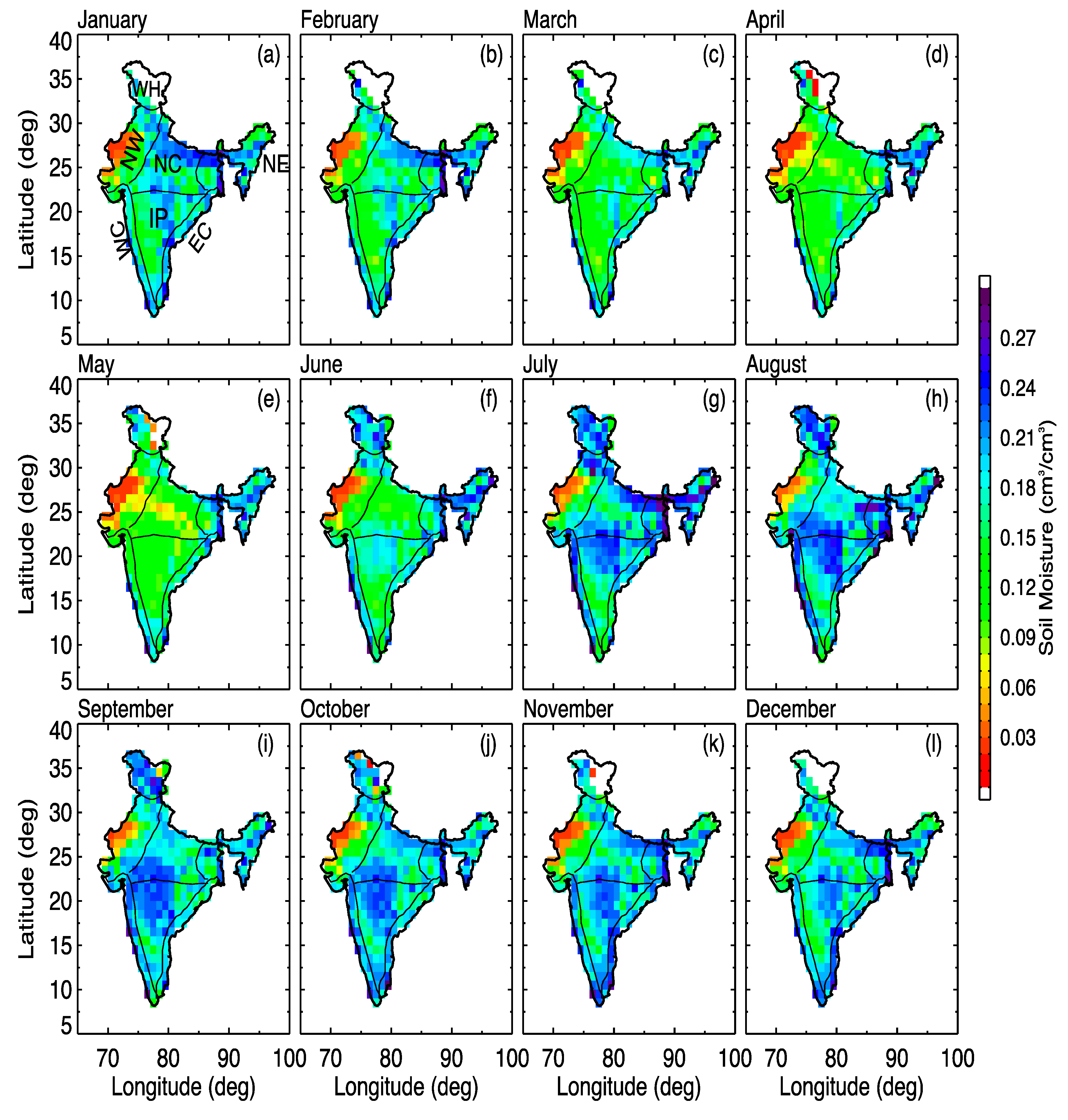
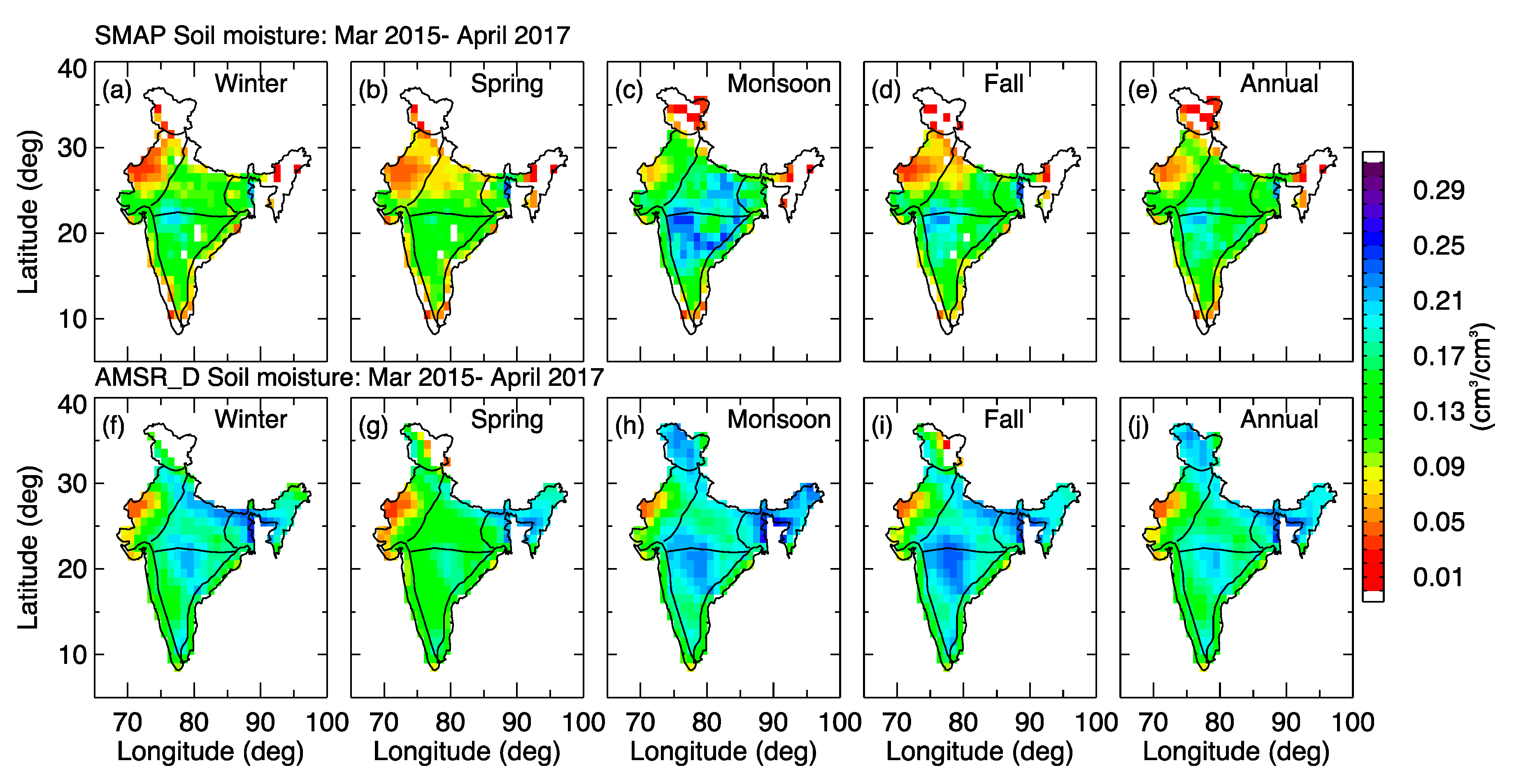
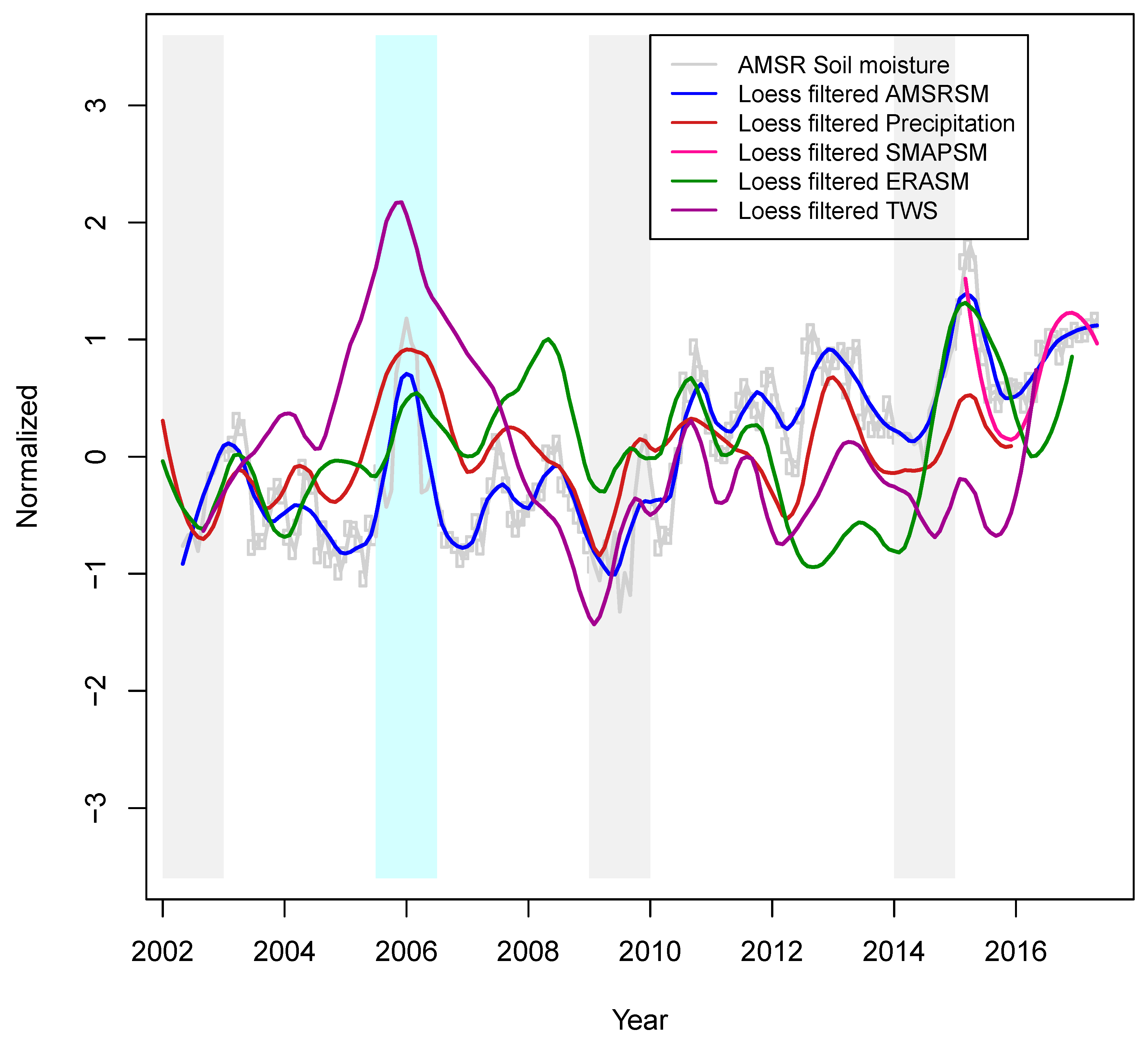
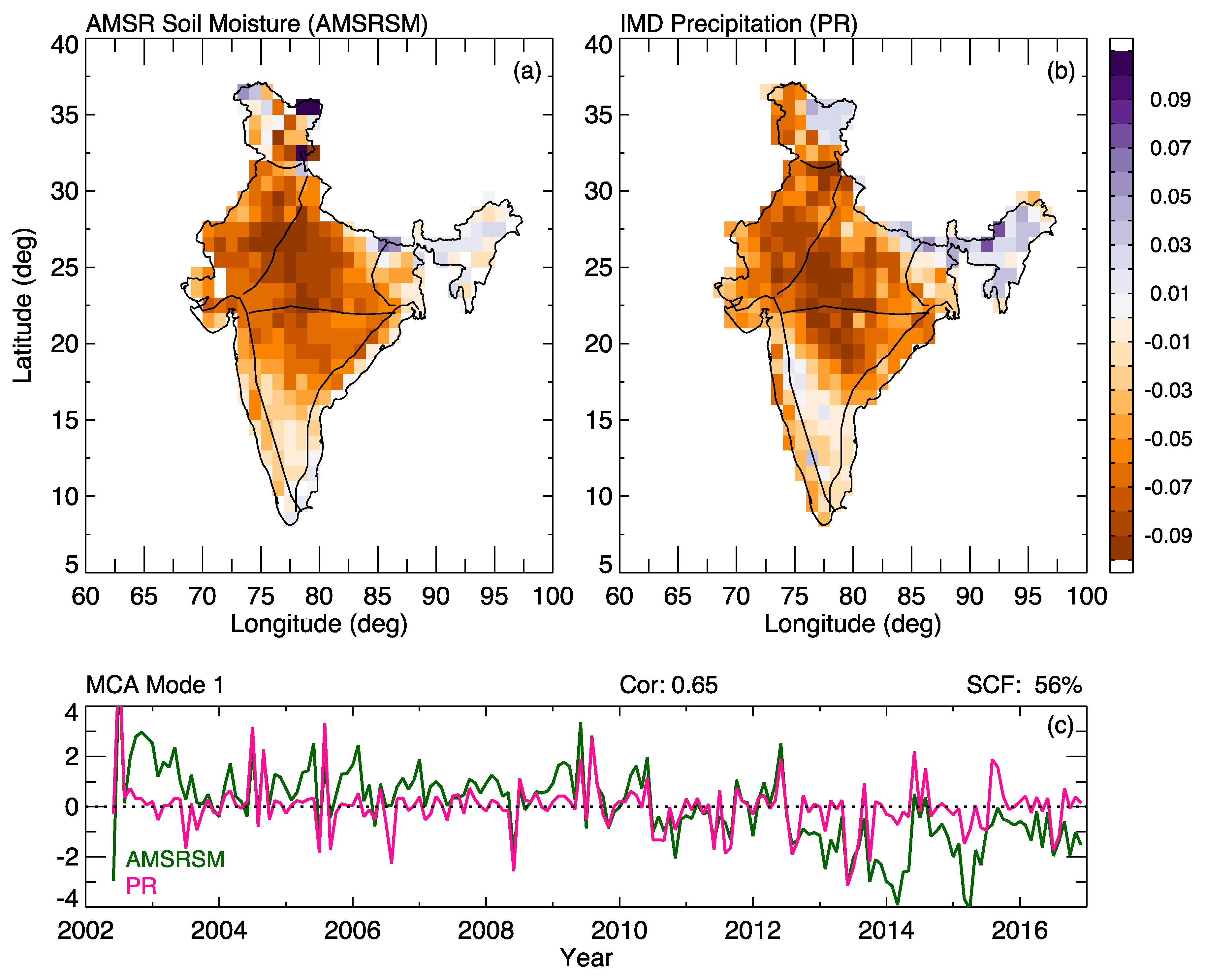
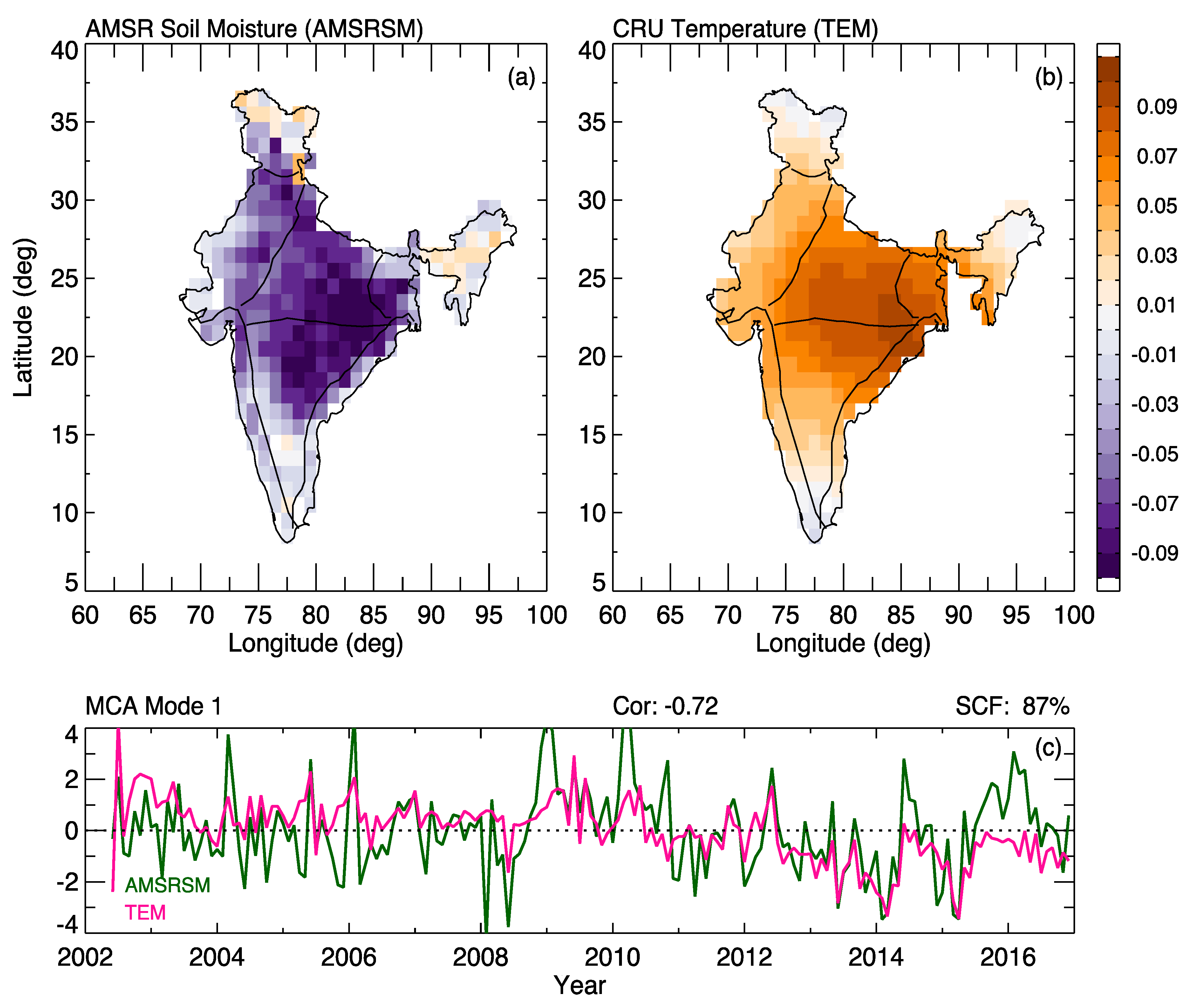
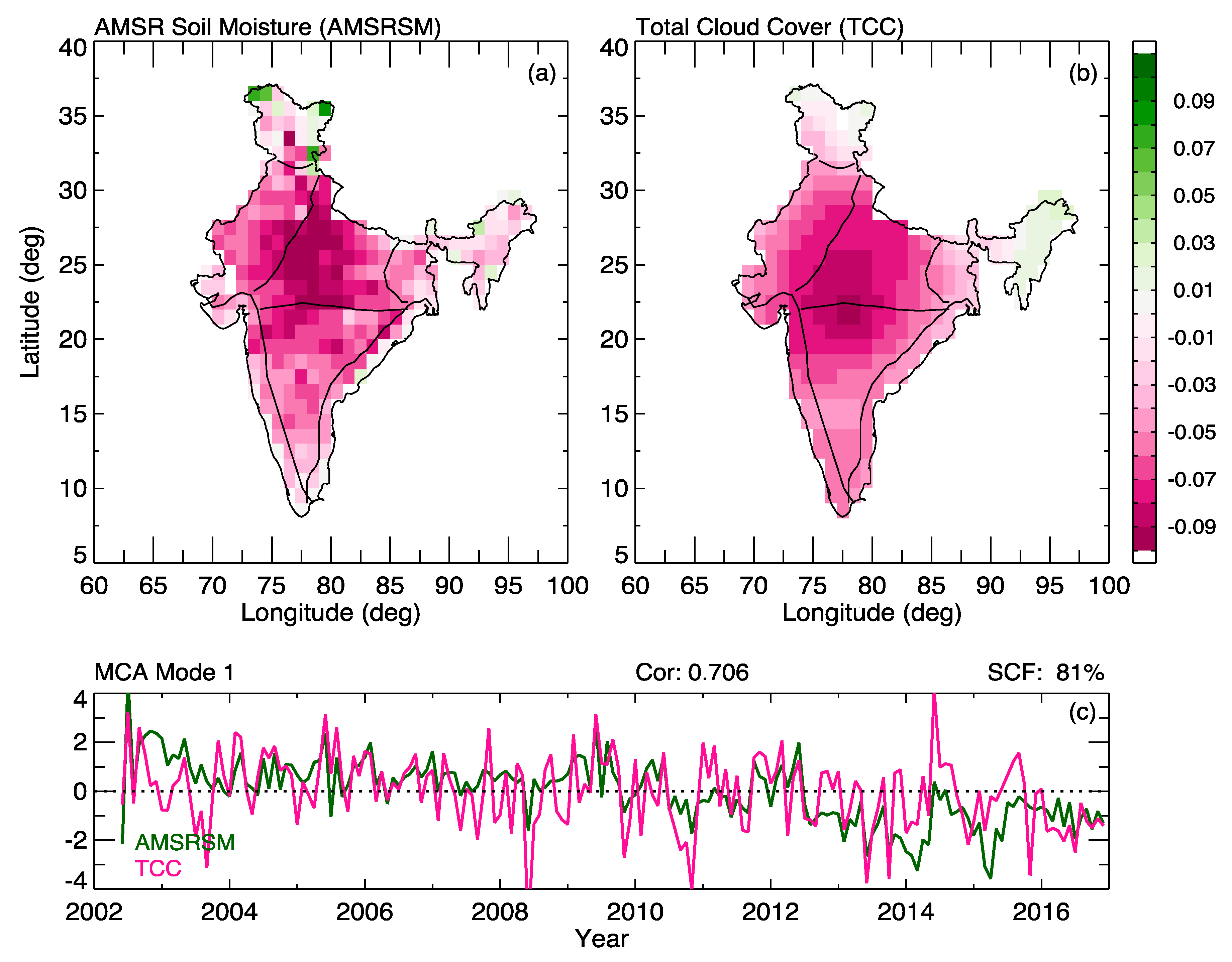
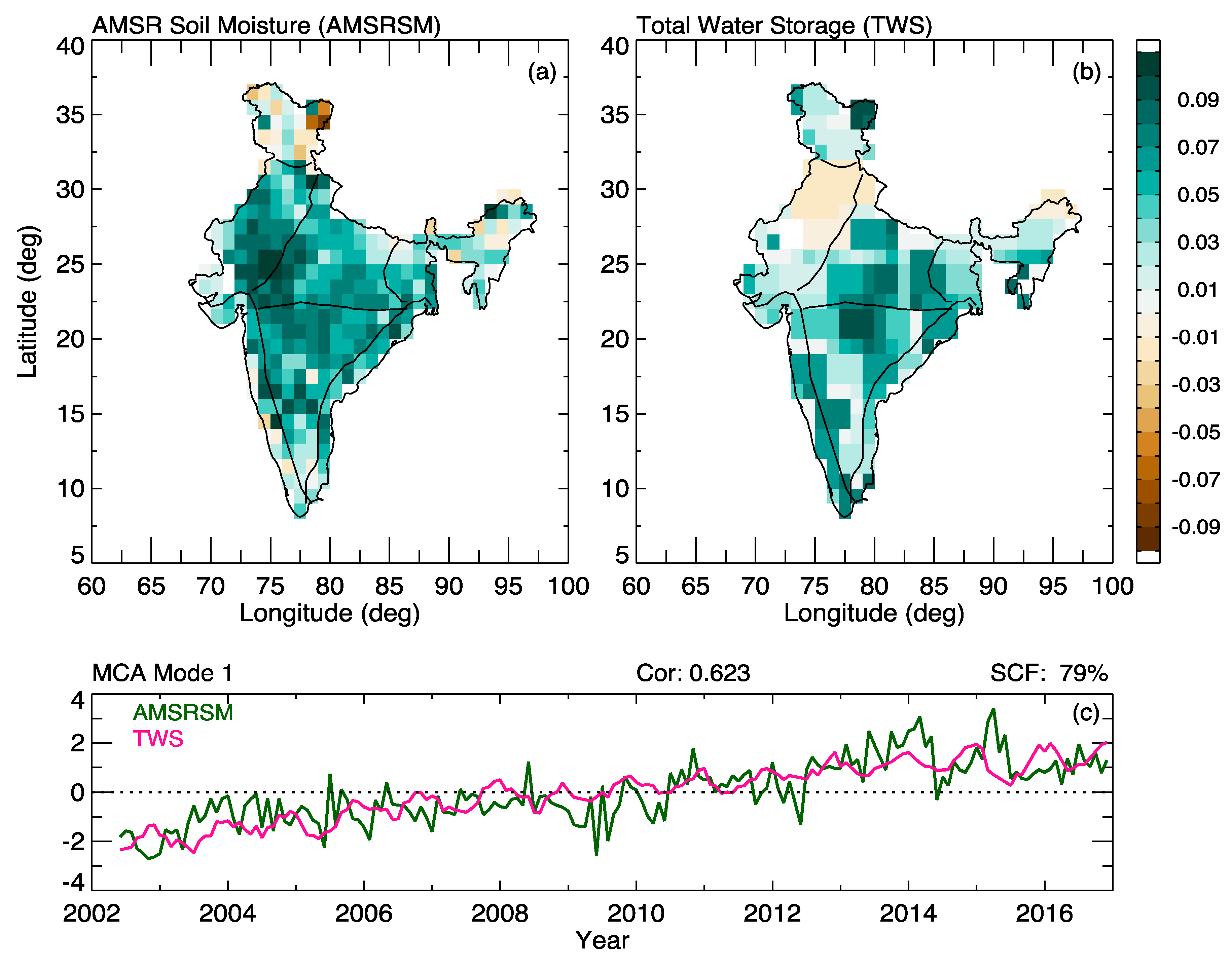
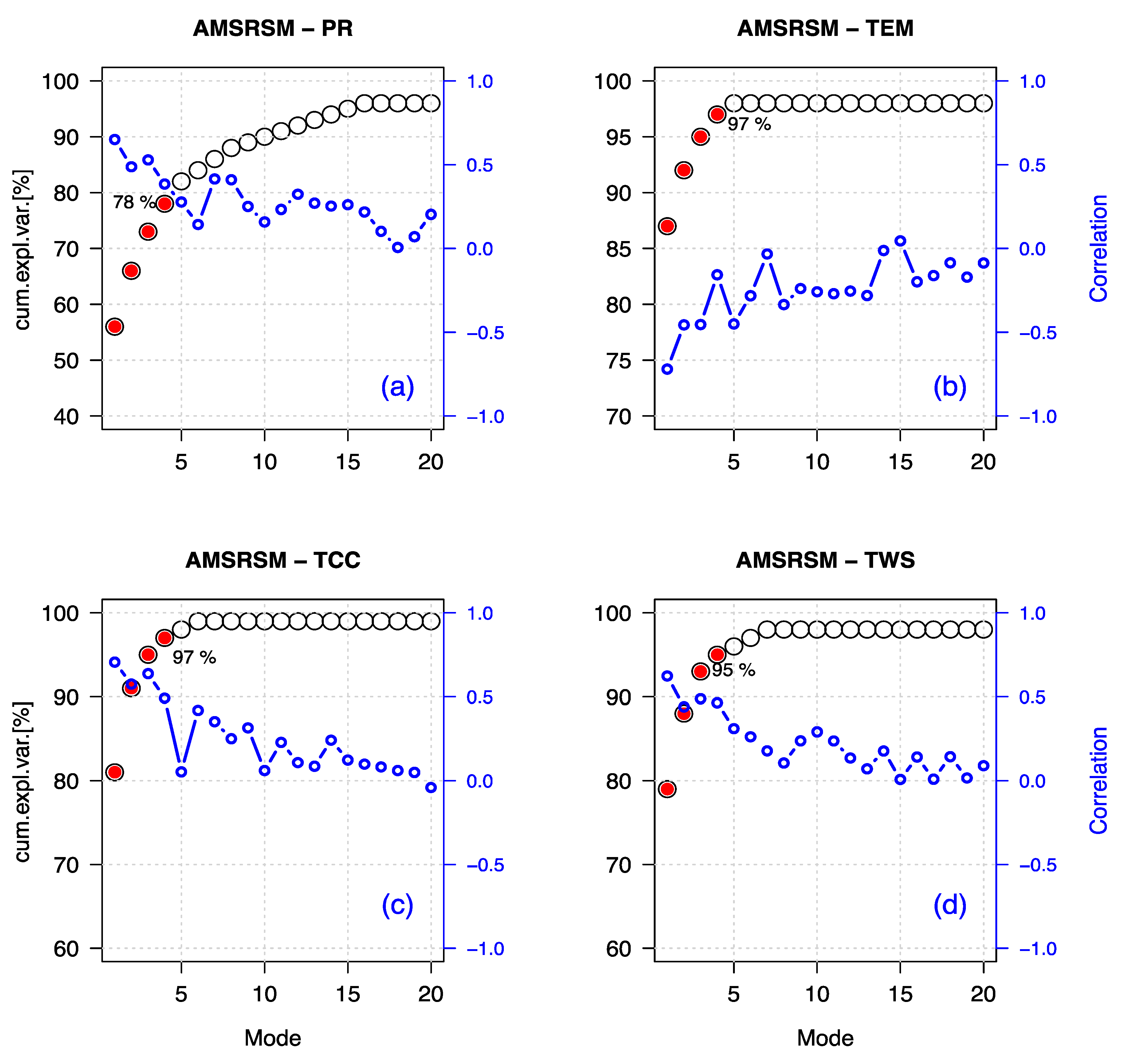
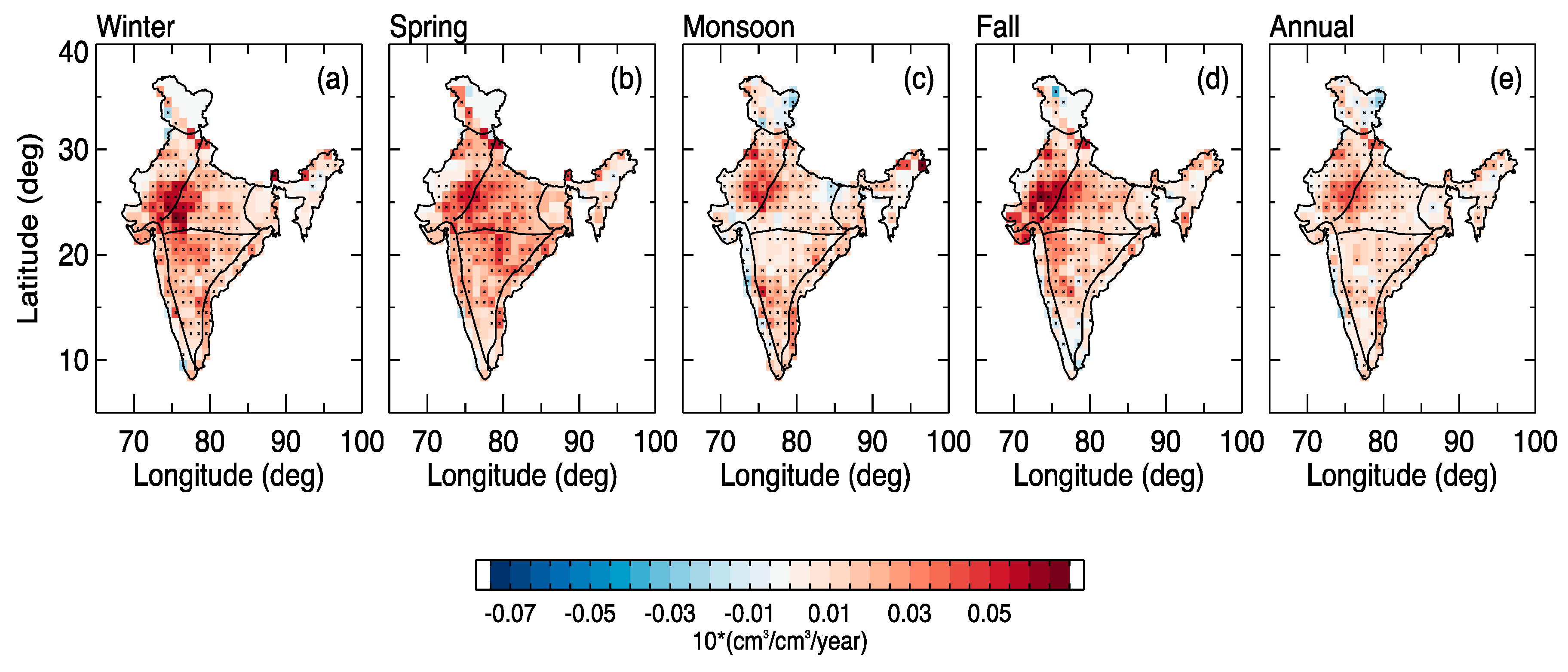
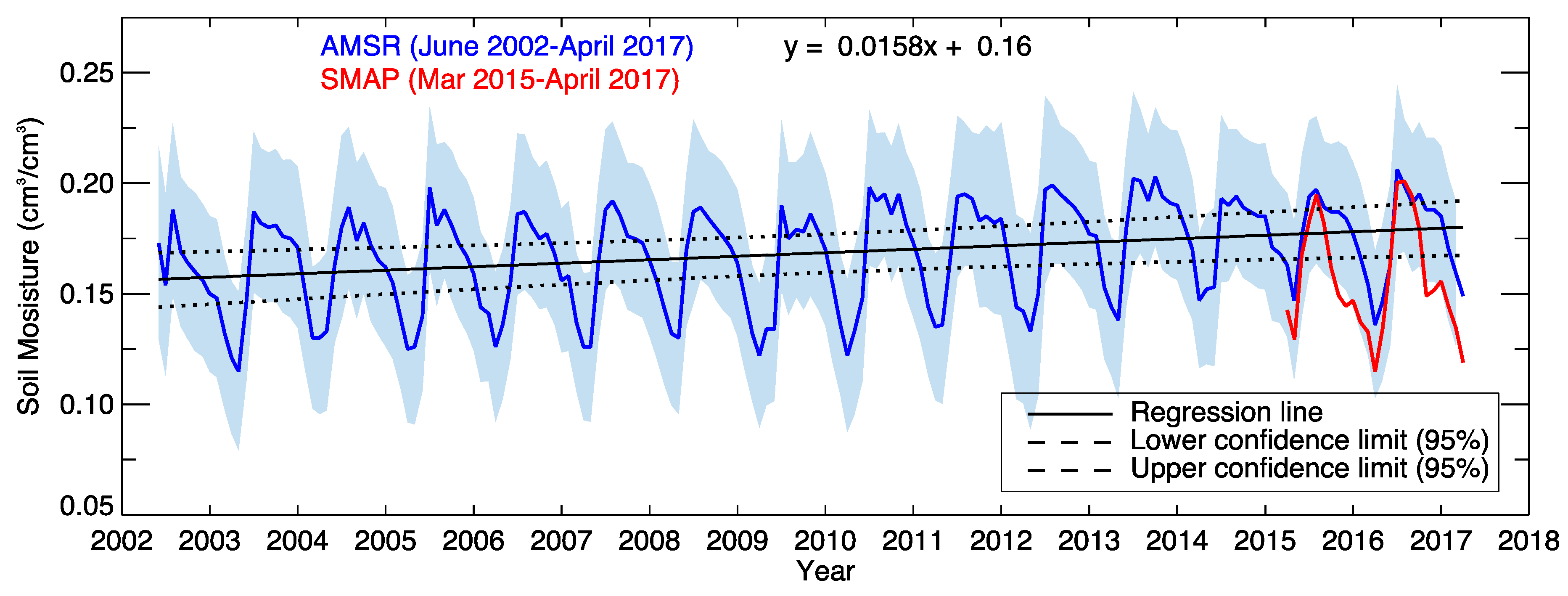
| AMSR (March 2015–April 2017) | |||||
| Region | Winter (DJF) | Spring (MAM) | Monsoon (JJAS) | Fall (SO) | Annual |
| East coast (EC) | 0.188 (0.025) | 0.154 (0.069) | 0.206 (0.039) | 0.155 (0.076) | 0.201 (0.039) |
| Interior Peninsula (IP) | 0.178 (0.032) | 0.148 (0.029) | 0.196 (0.027) | 0.203 (0.027) | 0.178 (0.026) |
| North Central (NC) | 0.193 (0.031) | 0.151 (0.032) | 0.192 (0.025) | 0.202 (0.025) | 0.181 (0.026) |
| North east (NE) | 0.202 (0.045) | 0.198 (0.037) | 0.218 (0.038) | 0.205 (0.030) | 0.206 (0.033) |
| North west (NW) | 0.125 (0.032) | 0.101 (0.035) | 0.141 (0.042) | 0.135 (0.047) | 0.126 (0.061) |
| West coast (WC) | 0.180 (0.045) | 0.166 (0.050) | 0.202 (0.049) | 0.200 (0.047) | 0.185 (0.046) |
| Western Himalaya (WH) | 0.188 (0.025) | 0.154 (0.069) | 0.206 (0.039) | 0.155 (0.076) | 0.201 (0.039) |
| SMAP (March 2015–April 2017) | |||||
| East coast (EC) | 0.119 (0.065) | 0.125 (0.063) | 0.168 (0.105) | 0.137 (0.085) | 0.133 (0.078) |
| Interior Peninsula (IP) | 0.148 (0.052) | 0.138 (0.044) | 0.198 (0.078) | 0.173 (0.057) | 0.160 (0.059) |
| North central (NC) | 0.135 (0.067) | 0.107 (0.041) | 0.194 (0.062) | 0.139 (0.064) | 0.147 (0.049) |
| North east (NE) | 0.139 (0.092) | 0.143 (0.103) | 0.148 (0.093) | 0.169 (0.103) | 0.141 (0.091) |
| North west (NW) | 0.083 (0.032) | 0.072 (0.041) | 0.127 (0.048) | 0.091 (0.050) | 0.095 (0.051) |
| West coast (WC) | 0.126 (0.074) | 0.108 (0.060) | 0.164 (0.094) | 0.144 (0.084) | 0.133 (0.077) |
| Western Himalaya (WH) | 0.088 (0.064) | 0.069 (0.03) | 0.052 (0.034) | 0.059 (0.050) | 0.050 (0.036) |
© 2019 by the authors. Licensee MDPI, Basel, Switzerland. This article is an open access article distributed under the terms and conditions of the Creative Commons Attribution (CC BY) license (http://creativecommons.org/licenses/by/4.0/).
Share and Cite
Pangaluru, K.; Velicogna, I.; A, G.; Mohajerani, Y.; Ciracì, E.; Charakola, S.; Basha, G.; Rao, S.V.B. Soil Moisture Variability in India: Relationship of Land Surface–Atmosphere Fields Using Maximum Covariance Analysis. Remote Sens. 2019, 11, 335. https://doi.org/10.3390/rs11030335
Pangaluru K, Velicogna I, A G, Mohajerani Y, Ciracì E, Charakola S, Basha G, Rao SVB. Soil Moisture Variability in India: Relationship of Land Surface–Atmosphere Fields Using Maximum Covariance Analysis. Remote Sensing. 2019; 11(3):335. https://doi.org/10.3390/rs11030335
Chicago/Turabian StylePangaluru, Kishore, Isabella Velicogna, Geruo A, Yara Mohajerani, Enrico Ciracì, Sravani Charakola, Ghouse Basha, and S. Vijaya Bhaskara Rao. 2019. "Soil Moisture Variability in India: Relationship of Land Surface–Atmosphere Fields Using Maximum Covariance Analysis" Remote Sensing 11, no. 3: 335. https://doi.org/10.3390/rs11030335
APA StylePangaluru, K., Velicogna, I., A, G., Mohajerani, Y., Ciracì, E., Charakola, S., Basha, G., & Rao, S. V. B. (2019). Soil Moisture Variability in India: Relationship of Land Surface–Atmosphere Fields Using Maximum Covariance Analysis. Remote Sensing, 11(3), 335. https://doi.org/10.3390/rs11030335





